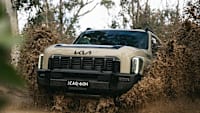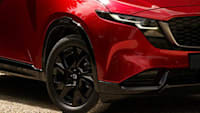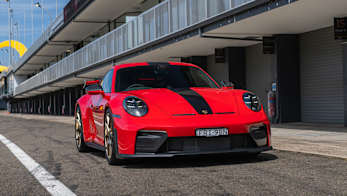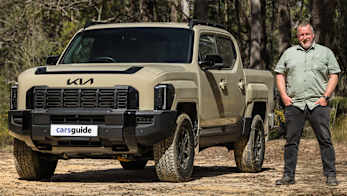Could Mazda finally crack the hot-hatch code that seems to have eluded it for years courtesy of its plug-in hybrid electric vehicle (PHEV) with rotary-engined range-extender (REx) technology?
This is not as far fetched as it sounds, and it may not be that far away either, as the company finally ups the pace on electrification across all future models, from the smallest and sportiest like the next-generation MX-5 to the imminent CX-90 PHEV full-sized SUV flagship.
However, what might really capture buyers imaginations is the prospect of the next Mazda3 reviving the MPS (Mazda Performance Series) hot-hatch concept, if not, name. This would be a high-performance take on the hugely anticipated REx powertrain that’s heading for the MX-30 SUV sometime next year.
-
Now is the time to revive the Mazda3 MPS! Where is the Japanese brand's rival to the Volkswagen Golf R, Subaru WRX, Hyundai i30 and Toyota GR Corolla
-
Rotary's back, baby! Updated 2023 Mazda MX-30 electric car here next year along with rotary range-extender option
-
Mazda confirms rotary revival: "It's fundamental to the brand"
Right now, there’s only speculation about a Mazda3-based REx, but it is clear that the powertrain would be a natural fit for the upwardly mobile small car moving forward, well as a characteristically unique take on the hot-hatch theme for a brand renowned for seeking its own path.
The REx’s potential as a Subaru WRX or Volkswagen Golf GTI weapon is compelling. All the instantaneous torque of an electric motor, paired with a modestly-sized (and massed) battery pack and charged up by a tiny yet turbine-smooth rotary engine on the go or plugged into a socket when parked, all while delivering brilliant economy. Combined with a low centre of gravity and the powertrain components evenly spread across the platform, this set-up seems destined to provide driving thrills.
Given that the quirky MX-30 crossover, currently offered only as a mild hybrid or EV, is set to be the first REx, the architecture is already in place for both the next-gen Mazda3 as well as its closely-related CX-30 SUV sibling to follow suit, if so desired.
All three models are currently built on variations of the company’s snappily-named New Small Car Architecture that debuted in the existing Mazda3 back in late 2018. We’re expecting the coming redesign (or substantial facelift) in 2024 to be an evolution of this hardware, as it was engineered to be future proofed for electrification from the beginning.
Patent filings exposed last year reveal several REx scenarios Mazda is contemplating, and across its entire range network it seems as well, with ‘e-SkyActiv R-Energy’, ‘e-SkyActiv R-HEV’ and ‘e-SkyActiv R-EV’ branding. These are thought to cover rotary-enhanced mild, full and plug-in hybrid EV applications respectively.

Note, too, that although the MX-30 REx has been confirmed as an electricity generator that won’t drive any of the wheels - the electric motor will do that - other patent schematics seem to show all-wheel drive configurations, meaning that there’s plenty we still do not know about what may end up transpiring with the rotary. Will the latter be set up to drive the wheels as well? Or will it simply service two (or more) electric motors?
Inevitably, such advanced tech wouldn’t come cheap.
A Mazda3 MPS REx would play right into the Hiroshima brand’s premium aspirations, especially in the C-segment, giving it a unique selling proposition not only against the Golf GTI (from $55,000 before on-road costs) and co, but also electrified alternatives such as the newly-released Cupra Leon VZe and even the Mercedes-Benz A250e PHEV, which kick off from around $60,000 and $70,000 respectively.
Mazda executives in North America have confirmed that the REx in the MX-30 PHEV EV significantly increases range as a result of the “near silent” rotary engine only powering up the battery pack in the background; US reports have quoted figures of up to 400km between recharges, or from the current MX-30 EV’s disappointing 200km to around 330km using the real-world WLTP method.
.jpg)
Of course, considering the weight differences between a current Mazda3 G20e M Hybrid and its equivalent-grade MX-30 G20e M Hybrid (1361kg versus 1481kg), range as well as performance, agility and efficiency would greatly favour the lower, lighter and nimbler small car when contemplating any future REx applications.
What we’re saying is the Mazda3 appears to be tailor made for a REx hot-hatch application. It would also give the brand the talking point no rival could match in the fiercely-competitive GTI class.
Vitally, this might be the key to unlock the door to success in an arena that’s proven to be so elusive for Mazda, certainly since the ‘80s and ‘90s heyday of the 323/Familia Turbo AWD.
.jpg)
In the latter 2000s and early 2010s, over two memorable generations, the BK and BL Mazda3 MPS grades both possessed on paper what was required to show the likes of the Ford Focus ST/XR5 Turbo, Golf GTI and Renault Megane RS who was boss. More power. More body. More attitude. More kit.
But in reality, despite delivering exciting looks, performance and handling, they failed to gain traction – both metaphorically with buyers, as well as literally with the bitumen due to bewildering torque steer. Plus, there was no auto option to take on the burgeoning dual-clutch transmission craze. Another hot-hatch clone, it was all seen and done before, except with added flaws.
Not a future MPS REx, though. This one would look to blaze trails as well as burn rubber. Go on, Mazda, build it.








.jpg)







.jpg)

.jpg)
.jpg)

.jpg)






.jpg)

